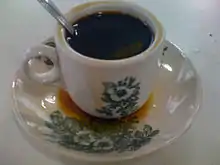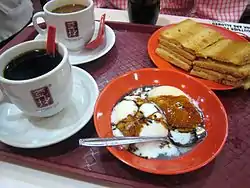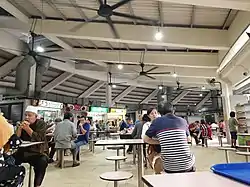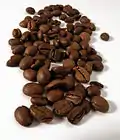Kopi (drink)
Kopi (from Coffee) is a type of traditional coffee originating from Singapore.[1][2][3][4] It is a highly caffeinated black coffee served with milk and sugar. This drink has Hainanese roots, being also otherwise known as Nanyang coffee. Nanyang means ‘South Sea’ in Mandarin, and usually references to lands within Maritime Southeast Asia that are located south of the islands of Hainan and Taiwan.[5]
 Kopi O served in a traditional cup in Singapore | |
| Type | Usually served hot or occasionally warm |
|---|---|
| Place of origin | Singapore[1][2][3] |
| Region or state | Singapore, also Maritime Southeast Asia and parts of Oceania |
| Associated national cuisine | Singapore[1][3][4] |
| Main ingredients | Coffee beans |
The coffee is recognized to be culturally significant and part of the everyday diet and lifestyle of many Singaporeans.[2] It is habitual for Singaporeans of all ethnicities and ages to customize their Kopi using the Hokkien dialect.[6] The coffee is also popular in other parts of the Asia-Pacific, such as Australia (especially Christmas Island and Perth), Indonesia and Malaysia.
The Singapore coffee is distinct from other types of coffee due to its roasting process and preparation technique involving a variation of the Torrefacto method.[5] It is usually served in coffee shops, Hawker centre and kopitiams.[3] There are also many commercial brands that have emerged specializing in serving the traditional coffee with pairings of local fare such as kaya toast and laksa.[5] Concerns over the elevation of diabetes cases, have caused the creation of government-led nationwide campaigns in Singapore to reduce sugar intake, especially with regard to sweet drinks or drinks that add sugar such as Kopi O.[7] This has the potential to affect the consumption of Kopi O.[7] The significance of Kopi in Singapore’s culture can be found in greater detail in Singapore’s only Kopi museum.[4]
Etymology

Local Kopi vocabulary governs the way consumers order their preferred style of Kopi in Singapore. The local Kopi vocabulary is grounded in Hokkien dialect. This transcendence of Hokkien dialect into the Kopi culture can be linked to the prominence of Hokkien immigrants in Malaya and Singapore.[8]
According to the history of Chinese immigration, millions of China residents left due to natural calamities and political instability during the 19th Century.[9] In the beginning, 50,000 Chinese landed in Singapore – many of them Chinese traders.[9] This number grew to 200,000 in 1900 as more passed through the Malay States and Dutch East Indies into Singapore. Amongst the arrivals, the Hokkiens made up the largest proportion of Chinese dialect groups in Singapore.[9] Thus, they also came to possess a dominant share of the banking, manufacturing and trade industries.[8]
Variations in style of Singapore’s traditional coffee revolve around denseness, sugar level, and additions of evaporated milk, condensed milk or ice. The terms used to order these variations, along with their respective meanings, can be found below.[6]
- Kopi: Coffee with sugar and condensed milk
- Kopi-O: Coffee with sugar
- Kopi-O-Kosong: Coffee without sugar and evaporated milk
- Kopi-C: Coffee with sugar and evaporated milk
- Kopi-Peng: Iced coffee with sugar and condensed milk
- Kopi-Siew-Dai: Coffee with less sugar and condensed milk
- Kopi-Siew-Siew-Dai: Coffee with little sugar and condensed milk
- Kopi-Ga-Dai: Coffee with extra sugar and condensed milk
- Kopi-Gao: Coffee with sugar, condensed milk and extra thick concentrated coffee
- Kopi-Di-Lo: Coffee with no dilution
- Kopi-Poh: Coffee with extra dilution
In addition to local variations, there are also diverse overseas combinations and variations of Kopi. This includes Yuenyeung or Kopi Cham which is a mixture of coffee and tea popular in Malaysia and Hong Kong.[10] Kopi is also otherwise known as Nanyang coffee. Nanyang means ‘South Sea’ in Mandarin, and usually references the lands of Southeast Asia located directly south of China.[5]
History
Origins in Singapore
The origin of Kopi in Singapore is intertwined with the demographic, industrial and cultural history of Singapore. In 1821, the Hainanese arrived in Singapore to trade medicinal herbs, umbrellas and wax amongst other things.[11] They did not immigrate to Singapore until much later in the 1870s due to conservative attitudes and delayed open trade and seafaring activities.[12]
This left the Hainanese at an employment disadvantage compared to earlier arrivals like the Hokkien, Teochew and Cantonese, whom had already entrenched themselves into industries like commerce and agriculture, due to aid from exclusivist clan associations.[3] The Hainanese were a small group, unable to communicate easily with other Chinese groups due to dialect differences and were both illiterate and poor.[12] These circumstances forced them into the service sector, where they found work as rubber tapers, waiters, and more popularly, cooks and domestic servants in rich European and Peranakan households.[3]
From the late 1920s to early 1930s, the economic downturn incentivized the Hainanese to turn to the hotel, bar and restaurant landscape due to lower rental rates.[12] The competition from Cantonese single women immigrants and reduction of British and Peranakan families after World War II also impacted the viability of remaining in the services sector.[3] Thus, the Hainanese relied upon their culminated culinary and personal service skills, and increasingly ventured into setting up their own coffeeshops or kopitiams from the 1920s to 1950s.[13] The support from the Hainanese association members aided this successful transition.[14] It is recognized that the Hainanese community played a pioneering and pivotal role in the emergence of the kopitiam culture in Singapore.[15]
It was through these Hainanese kopitiams that distinctive techniques of roasting coffee beans and brewing coffee were created, and Kopi along with its variations in Singapore was birthed.[3]
Events of influence
During the Japanese Occupation, black market traders often used coffee shops to sell rice, salt and sugar to the public.[16] By mid-1944, tighter restrictions and increased scarcity forced most coffee shops to close.[16] The remaining only offered Kopi without sugar and milk.[16] This meant consumption and availability of Kopi O greatly reduced.
Key events also shaped the Kopi landscape in late 1900s Singapore, affecting the price, availability and consumption.
The rapid trend of buying kopitiams in Singapore began in 1988.[3] A direct effect of a change in policy, that enabled privatization of ownership of kopitiams previously under the Housing Development Board.[3] Kopitiams became attractive property investments.[3] This caused the prices of kopitiam properties for sale and resale to rise sharply.[3] The result also encompassed the practice of selling new purchases to another owner, who would then renovate the place to justify increased rents onto the tenants.[17] Another pattern of holding the kopitiam for short periods of time and selling them off to make money quickly also emerged.[3]
The overarching economic result directly impacting stallholders and consumers, was an exponential growth in food and rent prices. Examples included increases of rent by S$1000, a 30% to 70% hike in prices of dishes, and a close to 100% increase in price for a cup of Kopi.[18] In 2006, the price of a Kopi O rose from 60 cents to 70 cents.[19] Similarly, in 2016, due to increased rent and labor costs, kopi prices rose from S$1.50 to $2, which caused unhappiness in patrons.[20]
The reactions of the public towards raised Kopi prices – writing complaint letters to The Straits Times and involving The Consumers Association of Singapore – serve as evidence with regard to the constant of Kopi in Singapore’s food culture and the integral role it plays in the everyday lifestyles of Singapore residents.[21]
Processing
Beans and sources

Kopi traditionally uses Robusta coffee beans. During the Straits Settlements, the Chinese partook in exchanges with Arab traders who carried with them Indonesian Robusta beans, and these beans grew better in Singapore’s conditions as opposed to Arabica beans.[22] The common type of Robusta beans used in Singapore is the Indonesia EK-1 species.[6] In 21st Century Singapore, Robusta beans continue to be largely imported from Indonesia and Vietnam.[23] In a bid to modernize, heritage brands such as Lam Yeo Coffee Powder Factory choose to use gourmet beans from South Africa and Central America.[24]
Roasting
The general traditional preparation process for Hainanese-style Kopi involves using a combination of 80% beans, 20% sugar and margarine in the roasting process for a duration of 25 minutes at 180 degrees Celsius.[5] Halfway into the roasting time, salt is added. Sugar is also added at the end to provide a caramelized finish and takeaway any bitter aftertaste.[5] The result is a richer and more fragrant coffee than Western-style coffee.[22] This method has been said to hold slight similarities to the common Torrefacto roasting method in Argentina, Costa Rica, France, Portugal and Spain.[6]
Serving
To serve, the grinded Kopi powder is placed in a muslin bag and boiling water is poured over it.[25] It is then stirred using a long stick or chopstick. After, the brew is transferred back and forth between two large cylindrical kettles with upright tubular spouts tapering to the pouring end.[25] The purpose is to aerate and cool the Kopi.
Nutrition
Kopi has twice the amount of caffeine found in Arabica coffee.[26] A regular cup of Kopi contains three teaspoons of sugar whereas Kopi-Siew-Dai has 1.5 teaspoons.[27] The World Health Organization recommends that an optimal sugar intake would border 5 teaspoons to bring about health benefits.[27]
Instant Kopi
The instant coffee market in Singapore is set to grow annually by 3.1% according to Statista.[28] In 2016 and 2017, the movement against Diabetes negatively impacted sales numbers.[23] This occurred alongside the growing appeal of coffee pods to consumers in Singapore.[23] One of the major contributing factors towards this trend, is the ability to control the amount of sugar and creamer used.[23]
National brands such as Toast Box produce their own instant Kopi products.[29] Instant Kopi can also be found in local supermarkets. The brands which provide traditional Kopi variations such as Kopi-O include Old Town, OWL, Gold Kili, Aik Cheong and Ah Huat.[30]
Modern variations
Younger generations of Singaporeans have created modern twists and recipes involving Kopi. An example is Coffee Break at Amoy Street that offers Almond Ginger Kopi which embodies a spicy and nutty flavor.[4] This depicts an existing progression away from the traditional methods of preparing Kopi in Singapore.
Sale and distribution
Consumer market

In Singapore there are an estimated 322 coffee shops and hundreds of them are found in the HDB estates.[3] This is alongside hundreds of food courts and Hawker centre.[3] Almost all of them, selling Singapore Kopi and its many variations. The established coffee shops include Tong Ah Eating House in Chinatown that has passed down four generations,[31] Killiney kopitiam that has received a heritage award, Heap Seng Leong – one of the few traditional coffee shops serving Kopi with butter,[32] and Ah Seng Coffee that began in the 1960s.[4]
There are also commercialized outlets that specialize in the Singapore traditional breakfast and Kopi. The household names include:
- Ya Kun, a Hainanese business that began in 1944. The chain is largely seen as culturally significant to Singaporean life and is also recognized for its kaya toast, another Singaporean dish.[33][34]
- Toast Box, that integrates heritage items into its décor and is known for their butter mountain display. It also conducts Nanyang coffee appreciation workshops.[35]
- and Nanyang Old Coffee, conceptualised in the 1940s and winner of ‘The Search for The Best Coffee Competition 2013’.[36] The brand also runs workshops.
An initiative by NTUC Foodfare and Kopitiam that began in 2019, continues to provide Kopi at discounted prices of $0.50 for Singaporeans part of the Pioneer and Merdeka generations, and the NTUC Union.[37] A regular cup of Kopi usually costs around $0.90 to $1.60 at Kopitiam outlets.[37]
Society and culture
Early consumption
During the early 1900s, porcelain cups were typically used to serve the Kopi.[38] These cups were decorated by the motifs or logos of the coffee suppliers.[38] Consumers would cool their Kopi by pouring it into the saucer and then drinking from it.[38] In the 1930s, some coffee roasters would use opium-infused water to roast their beans in order to make customers addicted to their brew.[22] There was also a practice of warming cold coffee in ceramic cups on a charcoal burner, to give the impression that the coffee was freshly made.[22] Blue-collared workers began to drink coffee instead of tea due to its stronger caffeine effect.[22]
More than 80% of the coffee-shops were run by Hainanese and Foochows, but they were often patronized by members of other communities such as Malays and Indians.[2] The main consumers of Kopi at these coffee-shops were men.[3] This was partly due to the small population of women immigrants, and the cultural expectation for them to remain at home or in their quarters.[3]
Another reason was the nature of kopitiams in Singapore, which served as recreation venues for men, gambling dens, and meeting places for secret society members.[2] The prevalence of prostitutes and escort girls at the kopitiams also discouraged women from sitting around.[2]
Modern consumption
Kopi makes up over 70% of the coffee consumed in 21st Century Singapore.[6] People from all income brackets, gender, age and communities can be found drinking the widely available Kopi – with some enjoying 4 to 6 cups a day.[23] The original ceramic cups have been widely replaced by glass at many coffee shops.[5] In Hawker centre, the takeaway option is served in a plastic bag.
This beverage is often paired with a traditional Singapore breakfast which consists of kaya and butter on charcoal-grilled toast, paired with two soft-boiled eggs.[5] Kaya is an egg jam combined with milk and sugar.[5] The Hainanese version is brown in color due to the use of caramelized sugar.[5] The Peranakan version is instead green in color due to the infusion of pandan leaves.[5] Both types are equally prevalent in Singapore. The breakfast holds links to the British style of breakfast and was popularized by the Hainanese.[5]
Health
In 2016, Singapore launched a nationwide campaign to tackle Diabetes.[39] A survey conducted by YouGov found that 42% of Singaporeans were supportive of a sugar tax in Singapore whereas 58% would favor a ban.[40] The attitudes of Singaporeans towards sugar has a direct impact on their preference of Kopi, since Kopi O involves addition of sugar. The 2018 healthier drinks policy has created mandatory guidelines for many food and beverage outlets, putting a control on the sugar content.[7] Coffee shop operator Kopitiam has also started the practice of serving sugar-free beverages, and leaving the sugar at the side of stalls for customers to add for themselves.[7] A trial conducted at the Health Promotion Board’s public canteen saw a 75% drop in the amount of sugar used, when the self-help practice was implemented.[7] With 430,000 Singaporeans with diabetes in 2018, the dwindling appeal of Kopi O shows potential of being a long-term constant.[7]
Events and competitions
Singapore coffee-related events[6]:
- The Singapore Coffee Festival
- Organized by the Straits Times and supported by DBS Bank.
- Held on 4th to 6th August
- Consists of merchants ranging from cafes to retail shops and workshops.
- Singapore Coffee Auction
- Organized by the Singapore Coffee Association (SCA) for farmers to promote their coffee beans to the regional and Singapore market.
- Specialty Coffee and Tea Asia
- Organized by Montgomery Asia Pte Ltd
- A convention for all supply chain participants in the coffee and tea industry to congregate, showcase and network
Singapore coffee-related competitions[6]:
- Singapore National Barista Championship
- Singapore National Brewers Cup
- Singapore Coffee in Good Spirits Championship
- Singapore Cup Tasters Championship
Museum
The Nanyang Old Coffee Mini Singapore Coffee Museum is Singapore’s sole museum dedicated to Kopi history.[4] It traces the traditional roasting methods and features photographs, vintage items, and information regarding the Kopi landscape in Singapore, as well as those who partake in creating it. An example of an interesting tidbit of information is how empty condensed milk cans were reused as takeaway containers.[41]
References
- Dutta, Madhurima (22 February 2018). "What Makes Singapore's Coffee Culture So Unique?". theculturetrip.com. The Culture Trip. Retrieved 2 January 2021.
Around the 19th century, Singapore opened its doors to immigrants who would develop Singapore into a fast-growing modern nation. Chinese cooks began opening up kopitiams to serve the European working population and word has it that Europe’s penchant for coffee combined with the local flavors led to the introduction of kopi.
- Aljunied, Khairudin (2014). "Coffee-shops in Colonial Singapore: Domains of Contentious Publics". History Workshop Journal. 77: 65–85. doi:10.1093/hwj/dbt011. S2CID 154985319 – via Oxford Academic.
- Lai, Ah Eng (2015). "The Kopitiam in Singapore: An Evolving Story about Cultural Diversity and Cultural Politics". Food, Foodways and Foodscapes: 103–132. doi:10.1142/9789814641234_0006. ISBN 978-981-4641-21-0.
- "Order kopi like a local". www.visitsingapore.com. Retrieved 2020-05-19.
- "Traditional Breakfast of Kaya and Kopi". www.roots.sg. Retrieved 2020-05-19.
- "Singapore Coffee Association". Singapore Coffee Association. Retrieved 2020-05-19.
- Ng, Kelly (2018). "Sugar? No thanks: Patrons opt for healthier option when asked to sweeten beverages themselves". TODAYonline. Retrieved 2020-05-19.
- Guan, Kwa Chong; Lim, Kua Bak (2019-06-21). A General History Of The Chinese In Singapore. World Scientific. ISBN 978-981-327-765-6.
- Leong-Salobir, Cecilia (2019). Singapore: Tasting the City. Urban Food Culture. New York: Palgrave Macmillan. pp. 83–111. ISBN 978-1-137-52223-8.
- "Coffee or tea? With this drink, you get both". MNN - Mother Nature Network. Retrieved 2020-05-19.
- Lai, Chee Kien (2006). "Multi-ethnic Enclaves around Middle Road: An Examination of Early Urban Settlement in Singapore". BiblioAsia. 2 (2): 4–20 – via NLB.
- "Hainanese community | Infopedia". eresources.nlb.gov.sg. Retrieved 2020-05-19.
- Yap, Mui Teng (1990). Hainanese in the restaurant and catering business. Chinese dialect groups: Traits and trades. Singapore: Opinion books. pp. 78–90.
- Low, C. G. (1983). Chinese Dialect Groups. On Oral History Centre [MP3]. Singapore: National Archives of Singapore.
- The Straits, Times (2007). "Kopi connection". The Straits Times.
- Kratoska, Paul H. (1998). The Japanese Occupation of Malaya: A Social and Economic History. C. Hurst & Co. Publishers. ISBN 9780824818890.
- Han, Fook Kwang (2013). "HDB coffee shops are not district 10 bungalows". The Sunday Times. p. 40.
- Chan, Francis; Kua, Z.Y. (2007). "Record price for coffee shop means higher rents". The Straits Times.
- Lim, D (2006). "Kopi-O likely to cost more soon". The Straits Times.
- Wong, Siew Ying (2016). "Budget 2016: Of coffee prices and hopes of a helping hand". The Straits Times.
- Chang, Rachel; Ong, A (2011). "Wrestling with the beast – again". The Straits Times. pp. 36–37.
- Loh, Jahan (2015). One Kopi at a Time: Retracing Singapore's Coffee Culture. Singapore: Invasion Studios Pte Ltd.
- Doyle, Josh (2018-12-07). "Singapore's Cosmopolitan Coffee and Tea Culture". STiR Coffee and Tea Industry International - STiR is the international coffee and tea industry bi-monthly magazine website, local, global, equipment, machinery, supplies, services, market, intelligence, raw, product, retail, service news. Retrieved 2020-05-19.
- "Lam Yeo Coffee Powder Factory". www.roots.sg. Retrieved 2020-05-19.
- "Brass coffee dispenser kettle". www.roots.sg. Retrieved 2020-05-19.
- Pabari, Suneal (2014). "10 differences Between Robusta & Arabica Coffee". The Roasters Pack. Retrieved 2020-05-19.
- "Reduce Sugar in Your Coffee for a Healthier Drink". www.healthhub.sg. Retrieved 2020-05-19.
- "Instant Coffee - Singapore | Statista Market Forecast". Statista. Retrieved 2020-05-19.
- "Toast Box". www.toastbox.com.sg. Retrieved 2020-05-19.
- "Results For instant coffee | FairPrice". www.fairprice.com.sg. Retrieved 2020-05-19.
- Falkowitz, Max (2012). "Snapshots from Singapore: A Guide to Singaporean Coffee". Serious Eats.
- Chua, Gin (2019). "Heap Seng Leong – Old-school coffeeshop with Kopi Gu You & kaya toast". Ladyironchef.
- Low, Shi Ping (2007). "A toast to expansion in Asean". The Edge Singapore.
- HKTDC Research (2015). "Leveraging on the Singaporean Government's strong support – Interview with Ya Kun Kaya Toast".
- "Toast Box Singapore". www.facebook.com. Retrieved 2020-05-28.
- "Awards to Nanyang Old Coffee". nanyangoldcoffee.com. Retrieved 2020-05-28.
- Seow, Joanna (2019). "Coffee, tea at 50 cents for seniors and workers". The Straits Times.
- "Porcelain cup with 'Kilang Serbuk Kopi Sin Seng' logo". www.roots.sg. Retrieved 2020-05-28.
- "Singapore's War on Diabetes". www.healthhub.sg. Retrieved 2020-05-28.
- Tay, Rachel. "Almost 3 in 5 Singaporeans would support a total ban on high-sugar drinks: Survey, Business Insider - Business Insider Singapore". www.businessinsider.sg. Retrieved 2020-05-28.
- "Home of Nanyang Old Coffee | 南洋老咖啡". nanyangoldcoffee.com. Retrieved 2020-05-28.

